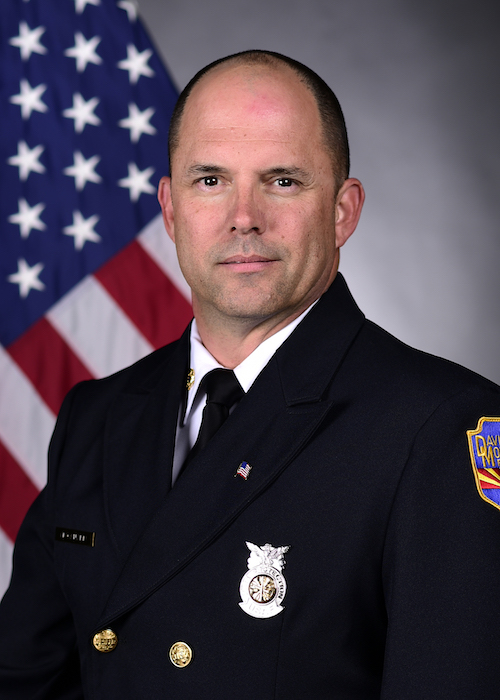
Chief Todd Canale, CFO
I had the distinct privilege to speak at our department’s annual award banquet last week and address our incredible team of firefighters and their families. While preparing for the evening and deciding what to present, I quickly focused on our newly formed Professional Firefighters Association and the impact it has had on both the department and community.
I contemplated that our accomplishments would not be possible without the tenacious and professional contributions of all those involved in creating the synergy to move our quest forward. As I reflected on this, I came to the realization that this is very typical of the ethos within the fire service. Our charge is a no fail mission and, as a profession, we will often go to great lengths to ensure mission success. As we recognized our annual award recipients and reflected on our accomplishments from the prior year, it was also a time to identify and articulate the opportunities for the coming year. I challenged each of our firefighters to take an introspective look at where they are personally and professionally and had them consider this question, “What can I do today to make the fire service and myself better tomorrow?”
Personal Improvement
The fire service is ever evolving and its members must embrace the notion of life-long learning and continuous improvement. As department and community leaders embrace data-driven decisions, firefighters are finding themselves in search of new skill sets and abilities. While firefighters, as a rule, possess the aptitude to develop these skills, they need the means to take their abilities to the next level. The Center for Public Safety Excellence’s (CPSE) Commission on Professional Credentialing (CPC) provides department leaders just such a vehicle to enhance their professional prowess. CPC provides fire service leaders five different credentialing programs to enhance their professional skills. Credentials include:
- Chief Fire Officer (CFO)
- Chief Training Officer (CTO)
- Chief EMS Officer (CEMSO)
- Fire Officer (FO)
- Fire Marshal (FM)
Credentialing provides proof of achievement and added credibility through a third-party rigorous process. In many professions, professional credentialing is often needed to practice or work at a stated level as in the case of an engineer’s Professional Engineer or architect’s Registered Architect designations. These credentials are not only expected, but often required. The fire service is trending in the same direction as organizational leaders are dealing with multi-million-dollar budgets, facilities and equipment, as well as hundreds of personnel.
The Commission on Professional Credentialing’s process is designed to fill this gap as the fire service continues to transition from a vocation to a profession. Each credential takes a “whole person” approach through the development of a portfolio that includes education, training, certifications, professional affiliations, professional and community contributions, along with professional competencies over an individual’s career. Once the application process is completed, the candidate’s portfolio is scrutinized by trained peer reviewers and a series of interviews are conducted. Upon the recommendation of the peer reviewer, the CPC Commission will review and vote on the candidate prior to awarding the designation, and this rigorous credentialing process may take in excess of six-months to complete.
Credentialing is only one tool in a fire service leader’s toolbox. Organizational leaders are being tasked more often and to a greater degree than in the past and require additional skills to meet the needs of their community and elected leaders. Along with advanced degrees, certifications, and professional affiliations, department leaders are finding themselves on par with their contemporaries and must have the requisite knowledge and abilities to compete in today’s fiscally constrained environment. Credentialing provides such advantage to fire service leaders.
Organizational Development
As with personal improvement, it is incumbent upon fire service members to continuously strive to take their departments to the next level. Often, the culture of fire service organizations is such that the members typically assimilate to the norms and values of the department which can potentially stifle independent thinking and create a parochial environment. By employing ambidextrous leadership, leaders can foster both explorative and exploitive behaviors within their department. Much like the term implies, organizations can meet the needs of today while projecting for tomorrow simultaneously.
Being able to forecast and meet the demands of today’s fire service is imperative in terms of service delivery and customer satisfaction. Fire service leaders must be able to “exploit” their departments to this end, ensuring community leaders are aware of their fiscal, material, and personnel needs. While many departments do this well, they often fall short when it comes to “exploring” future needs and trends. Ambidextrous leadership enables department leaders to complete both tasks simultaneously.
One such tool to assist in their endeavor is the Commission on Fire Accreditation International’s (CFAI) Accreditation Model. CFAI provides departments with the guidance and tools to take an introspective view at their departments through an extensive self-assessment and development of both a community risk assessment and strategic plan. As with ambidextrous leadership, fire chiefs can assess or “exploit” their current state through a rigorous and comprehensive self-assessment and community risk assessment while “exploring” the future through the development of the strategic plan, thus, creating the roadmap for the future.
The Accreditation process is an in-depth, multi-year process that requires the department to transcend through multiple levels of status on its way to agency accreditation. When a department is interested in the process, they become a Registered Agency and establish a three-year data set of information while beginning work on a self-assessment that includes ten categories and 252 performance indicators. Once achieved, departments will transition to Applicant status, essentially an 18-month window during which a strategic plan and community risk assessment will be developed along with refining the self-assessment. Once this phase is completed, departments then move to Candidate status where they are visited by a peer assessment team over a five-day period and, if meeting all of the criteria, are recommended for Accreditation and are scheduled to appear at a CFAI hearing at either CPSE’s Excellence Conference or the International Association of Fire Chief’s Fire-Rescue International Conference. Once accredited, departments report their progress on an annual basis and go through the re-accreditation process every five years.
Synthesizing Your Role within the Organization
While it is impossible to predict where the fire service will be in the next twenty years, it is incumbent upon its leaders to position their departments to the best of their ability to face the challenges of tomorrow. Fire chiefs must create and foster an environment of continuous improvement for its members. As the fire service continues to transition, both personal/professional credentialing and agency accreditation are the vehicles to prepare our profession for the future. Firefighters must be prepared to face these challenges, and by capitalizing on these programs can be better prepared to do so. I challenge you to ask yourself, “What can I do today to make the fire service and myself better tomorrow?”
